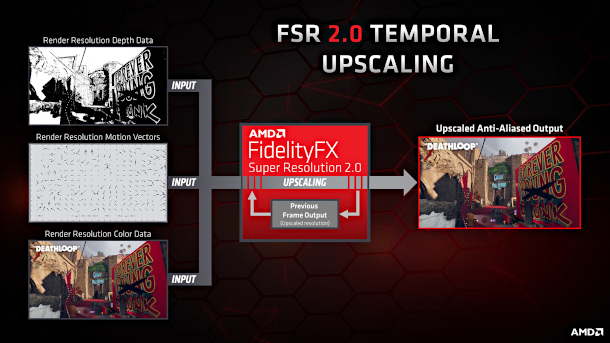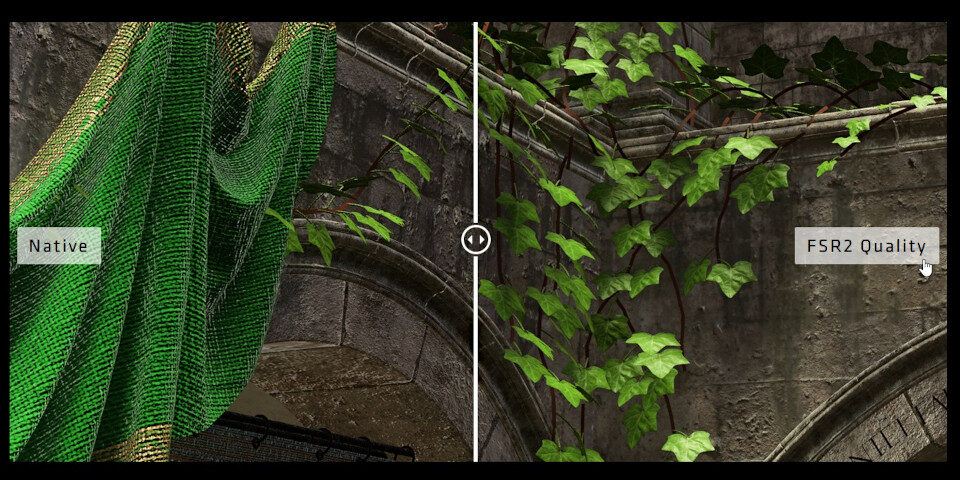AMD releases FSR 2.2
Originally posted on 21 March 2022. Scroll down for news of the FSR 2.2 update.
AMD has unveiled Fidelity FX Super Resolution 2 (FSR 2.0), the latest version of its open-source image upscaling technology, widely used in games and now also supported in AMD’s workstation GPU drivers.
The update, which is being previewed at GDC 2022 this week, and which is due to become available in “Q2 2022”, introduces support for temporal as well as spatial upscaling to improve the visual quality of output.
FSR render upscaling improves the frame rate of games – and now CAD and DCC apps
Launched last year, FSR is an image upscaling system, enabling software to render the screen at lower resolution, then upscale the result to the actual resolution of the user’s monitor.
The workflow improves frame rates over rendering natively at the higher resolution without loss of visual quality – or at least, without significant loss of quality if the increase in resolution isn’t too extreme.
AMD intially pitched the technology at game developers – it’s available natively in Unity, and there is a free plugin for Unreal Engine – with over 60 titles now supporting it, including God of War and Far Cry 6.
However, AMD has also integrated FSR into Radeon Pro Software for Enterprise, its suite of drivers and tools for its workstation GPUs, where it can be used to raise viewport frame rates in CAD and DCC apps.
FSR is already supported in Lumion, Act-3D’s real-time architectural visualisation software, with “other professional application software providers … planned for [the] future”.
Updated 21 February 2023: FSR is also now supported in GPU-based architectural renderer D5 Render.

FSR 2.0: support for temporal data improves upscaling quality
The key change in FSR 2.0 is support for temporal as well as spatial upscaling, with FSR now using data from previous frames – motion vectors, depth and colour data – rather than just the current frame.
According to AMD, the change not only improves the quality of the upscaled images over FSR 1.0 at all output resolutions, but delivers “similar or better than native image quality”.
You can judge that claim for yourself in the video at the top of the story, which shows side-by-side footage of Deathloop, Arkane Studios’ first-person shooter, running natively at 4K, and under FSR 2.0.
Unlike DLSS 2.0, Nvidia’s rival temporal upscaling system, which makes use of the Tensor cores in Nvidia GPUs, FSR 2.0 does not require dedicated machine learning hardware.
AMD’s blog post notes that FSR 2.0 will work with “select competitor graphics cards”, but there are no further details so far.

Updated 23 June 2022: AMD has released the source code for FSR 2.0.
As with FSR 1.0, it is available under an open-source MIT licence, and includes the full C++ and HLSL sources.
AMD has also posted detailed API documentation online, and updated the FSR 2 product page with more information and comparison images.
Updated 12 September 2022: AMD has released FSR 2.1. The update makes several changes to improve the temporal stability of upscaled footage, and to reduce ghosting artefacts, discussed in this blog post.
Updated 21 February 2023: AMD has released FSR 2.2.
The changes are mainly targeted at games rather than DCC tools: the biggest one is to reduce ‘high velocity ghosting’, seen in racing games where a third-person vehicle moves at speed over a flat surface.
AMD has also added a new Debug API Checker feature to pass debug messages from the FSR 2 runtime back to help troubleshoot new FSR integrations.
However, there are also changes to improve temporal luminance stability, reducing flickering on rendered objects, and to make FSR compatible with a “wider set of high dynamic range inputs”.
The Unreal Engine plugin has also been updated to support Unreal Engine 5.1.
Licensing and release dates
FSR 2.2 is compatible with Windows 10+, and supports DirectX 12 and Vulkan. The source code is available under a MIT licence.
The Unreal Engine plugin is available for Unreal Engine 4.26.2+.
